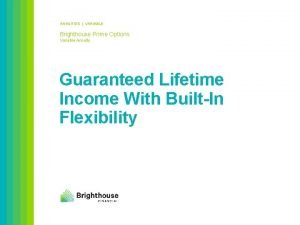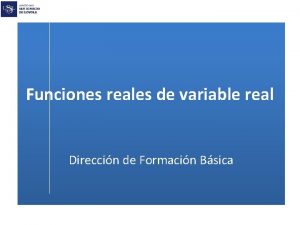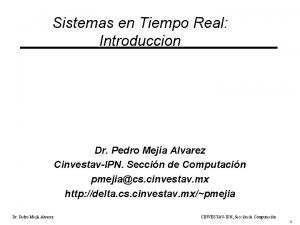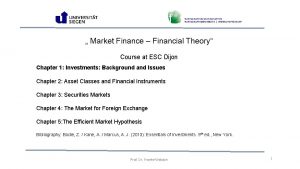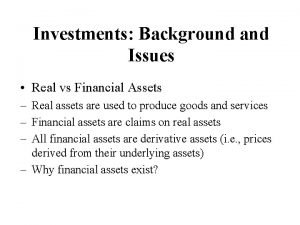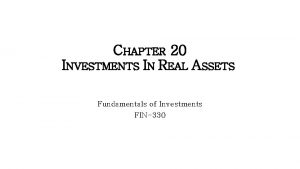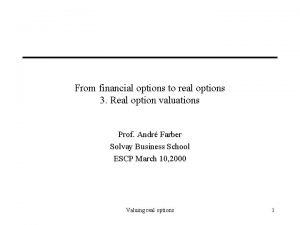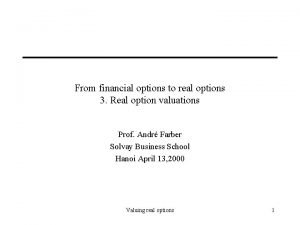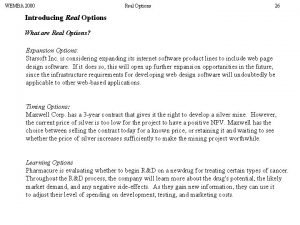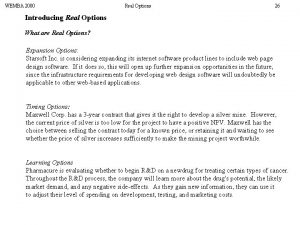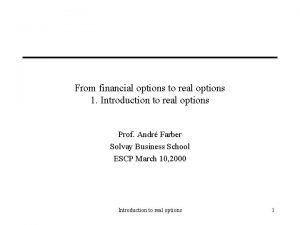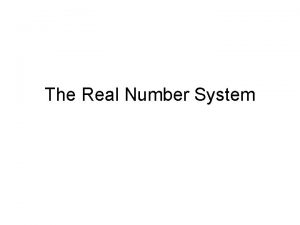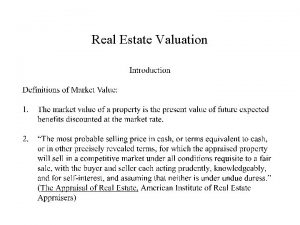From financial options to real options 2 Financial



















- Slides: 19

From financial options to real options 2. Financial options Prof. André Farber Solvay Business School Hanoi April 13, 2000 Financial options 1

Definitions • A call (put) contract gives to the owner – the right : – to buy (sell) – an underlying asset (stocks, bonds, portfolios, . . ) – on or before some future date (maturity) • on : "European" option • before: "American" option • at a price set in advance (the exercise price or striking price) • Buyer pays a premium to the seller (writer) Financial options 2

Terminal Payoff: European call • Exercise option if, at maturity: Stock price > Exercice price ST > K • Call value at maturity CT = ST - K if ST > K otherwise: CT = 0 • CT = MAX(0, ST - K) Financial options 3

Terminal Payoff: European put • Exercise option if, at maturity: Stock price < Exercice price ST < K • Put value at maturity PT = K - S T if ST < K otherwise: PT = 0 • PT = MAX(0, K- ST ) Financial options 4

The Put-Call Parity relation • • A relationship between European put and call prices on the same stock Compare 2 strategies: • Strategy 1. Buy 1 share + 1 put At maturity T: ST<K ST>K Share value ST ST Put value (K - ST) 0 Total value K ST • Put = insurance contract Financial options 5

Put-Call Parity (2) • • Consider an alternative strategy: Strategy 2: Buy call, invest PV(K) At maturity T: Call value Put value K Total value ST<K 0 K K ST>K ST - K ST • At maturity, both strategies lead to the same terminal value • Stock + Put = Call + Exercise price Financial options 6

Put-Call Parity (3) • Two equivalent strategies should have the same cost S + P = C + PV(K) where S current stock price P current put value C current call value PV(K)present value of the striking price • This is the put-call parity relation • Another presentation of the same relation: C = S + P - PV(K) • A call is equivalent to a purchase of stock and a put financed by borrowing the PV(K) Financial options 7

Valuing option contracts • The intuition behind the option pricing formulas can be introduced in a two-state option model (binomial model). • Let S be the current price of a non-dividend paying stock. • Suppose that, over a period of time (say 6 months), the stock price can either increase (to u. S, u>1) or decrease (to d. S, d<1). • Consider a K = 100 call with 1 -period to maturity. • • • u. S = 125 S = 100 Cu = 25 C d. S = 80 Financial options Cd = 0 8

Key idea underlying option pricing models • It is possible to create a synthetic call that replicates the future value of the call option as follow: – Buy Delta shares – Borrow B at the riskless rate r (5% per annum) • Choose Delta and B so that the future value of this portfolio is equal to the value of the call option. – Delta u. S - (1+r t) B = Cu Delta 125 – 1. 025 B = 25 – Delta d. S - (1+r t) B = Cd Delta 80 – 1. 025 B = 0 • ( t is the length of the time period (in years) e. g. : 6 -month means t=0. 5) Financial options 9

No arbitrage condition • In a perfect capital market, the value of the call should then be equal to the value of its synthetic reproduction, otherwise arbitrage would be possible: C = Delta S - B • This is the Black Scholes formula • We now have 2 equations with 2 unknowns to solve. • Eq 1 - Eq 2 Delta (125 - 80) = 25 Delta = 0. 556 • Replace Delta by its value in Eq 2 B = 43. 36 • Call value: • C = Delta S - B = 0. 556 100 - 43. 36 C = 12. 20 Financial options 10

A closed form solution for the 1 -period binomial model • C = [p Cu + (1 -p) Cd ]/(1+r t) with p =(1+r t - d)/(u-d) • p is the probability of a stock price increase in a "risk neutral world" where the expected return is equal to the risk free rate. In a risk neutral world : p u. S + (1 -p) d. S = 1+r t • p Cu + (1 -p) Cd is the expected value of the call option one period later assuming risk neutrality • The current value is obtained by discounting this expected value (in a risk neutral world) at the risk-free rate. Financial options 11

Risk neutral pricing illustrated • In our example, the possible returns are: + 25% if stock up - 20% if stock down • In a risk-neutral world, the expected return for 6 -month is 5% 0. 5= 2. 5% • The risk-neutral probability should satisfy the equation: p (+0. 25%) + (1 -p) (-0. 20%) = 2. 5% • p = 0. 50 • The call value is then: C = 0. 50 15 / 1. 025 = 12. 20 Financial options 12

Multi-period model: European option • For European option, follow same procedure • (1) Calculate, at maturity, - the different possible stock prices; - the corresponding values of the call option - the risk neutral probabilities • (2) Calculate the expected call value in a neutral world • (3) Discount at the risk-free rate Financial options 13

An example: valuing a 1 -year call option • Same data as before: S=100, K=100, r=5%, u =1. 25, d=0. 80 • Call maturity = 1 year (2 -period) • Stock price evolution Risk-neutral proba. Call value t=0 t=1 t=2 156. 25 p² = 0. 25 56. 25 100 100 2 p(1 -p) = 0. 50 0 80 64 (1 -p)² = 0. 25 0 • Current call value : C = 0. 25 56. 25/ (1. 025)² = 13. 38 Financial options 14

Volatility • The value a call option, is a function of the following variables: 1. The current stock price S 2. The exercise price K 3. The time to expiration date t 4. The risk-free interest rate 5. The volatility of the underlying asset • Note: In the binomial model, u and d capture the volatility (the standard deviation of the return) of the underlying stock • Technically, u and d are given by the following formula: • d = 1/u Financial options 15

Option values are increasing functions of volatility • The value of a call or of a put option is in increasing function of volatility (for all other variable unchanged) • Intuition: a larger volatility increases possibles gains without affecting loss (since the value of an option is never negative) • Check: previous 1 -period binomial example for different volatilities • Volatility u d C P • 0. 20 1. 152 0. 868 8. 19 5. 75 • 0. 30 1. 236 0. 809 11. 66 9. 22 • 0. 40 1. 327 0. 754 15. 10 12. 66 • 0. 50 1. 424 0. 702 18. 50 16. 06 • (S=100, K=100, r=5%, t=0. 5) Financial options 16

Black-Scholes formula • For European call on non dividend paying stocks • The limiting case of the binomial model for t very small • C = S N(d 1) - PV(K) N(d 2) Delta B • • In BS: PV(K) present value of K (discounted at the risk-free rate) Delta = N(d 1) d 1 = ln[S/PV(K)]/ t + 0. 5 t N(): cumulative probability of the standardized normal distribution B = PV(K) N(d 2) d 2 = d 1 - t Financial options 17

Black-Scholes : numerical example • 2 determinants of call value: “Moneyness” : S/PV(K) “Cumulative volatility” : • Example: S = 100, K = 100, Maturity t = 4, Volatility = 30% r = 6% “Moneyness”= 100/(100/1. 064) = 100/79. 2= 1. 2625 Cumulative volatility = 30% x 4 = 60% • d 1 = ln(1. 2625)/0. 6 + (0. 5)(0. 60) =0. 688 • d 2 = ln(1. 2625)/0. 6 - (0. 5)(0. 60) =0. 089 N(d 1) = 0. 754 N(d 2) = 0. 535 • C = (100) (0. 754) – (79. 20) (0. 535) = 33. 05 Financial options 18

Black-Scholes illustrated Financial options 19
 Flexchoice va rider
Flexchoice va rider Marketing real people real decisions
Marketing real people real decisions Polynomial functions used in real life
Polynomial functions used in real life Southpointe village apartments fishers in
Southpointe village apartments fishers in Funciones de variables reales
Funciones de variables reales Ch 9 ream people real choice case study
Ch 9 ream people real choice case study Slidetodoc.com
Slidetodoc.com The real real fashion copywriter
The real real fashion copywriter The real thing short story
The real thing short story Marketing real people real decisions
Marketing real people real decisions Sensor and (tiempo real or real time)
Sensor and (tiempo real or real time) Marketing real people real choices
Marketing real people real choices Lanni products is a start up computer
Lanni products is a start up computer Fundamentals of analyzing real estate investments
Fundamentals of analyzing real estate investments Real and financial assets
Real and financial assets Real assets definition
Real assets definition Real assets vs financial assets
Real assets vs financial assets Financial methods of motivation
Financial methods of motivation Gold guinea lot size
Gold guinea lot size Adoa benefit options
Adoa benefit options
